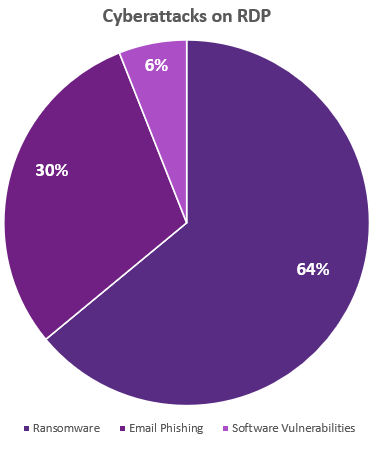
What Is an Operating System?
Learn what an operating system is. Understand the definition, as well as how it works and what types of operating systems are in use today from CompTIA, the voice of information technology.
 Computing used to be highly dependent on location. The original mainframes had no network connection at all – any work done on the machine had to be done in the same room. Eventually, networking and personal computers extended the reach of computing activity. For quite a long time, though, most business-related computing tasks were performed
within the office walls. Even as laptops became popular and people started working from a home computer, the work was typically limited. Certain systems could not be accessed from home or certain tasks could not be completed because of low bandwidth.
As technology has improved, many options are now available for enabling remote work. One of the most popular is remote desktop.
Computing used to be highly dependent on location. The original mainframes had no network connection at all – any work done on the machine had to be done in the same room. Eventually, networking and personal computers extended the reach of computing activity. For quite a long time, though, most business-related computing tasks were performed
within the office walls. Even as laptops became popular and people started working from a home computer, the work was typically limited. Certain systems could not be accessed from home or certain tasks could not be completed because of low bandwidth.
As technology has improved, many options are now available for enabling remote work. One of the most popular is remote desktop.
Remote desktop services provide a user on one computer access to another computer. The second computer may be in a completely separate location, but the user has access and remote control just as if they were working on their local system.
The second computer could be in a different location, it could be a desktop or mobile device, or it could be a virtual machine. There are many ways of enabling remote desktop, depending on the needs of the organization.
Remote desktop (or virtual desktop) solves two issues related to remote work:
First, if the end user is accessing a corporate system, the IT team can make all corporate applications available. All the work is still being done within the corporate network, and the data never has to leave the corporate confines, reducing cybersecurity vulnerabilities.
Second, bandwidth issues are restricted to the user interface. Bandwidth is a measure of how much data travels across network connections. If an employee is working on an application at home and then has to send all the data back to corporate servers, that can become cumbersome.
With remote desktop, all the actual compute work is being done at another location, so there is no concern over massive amounts of data having to travel back and forth. Low bandwidth can still create an unpleasant experience for the end user, but the work itself is not impacted nearly as much.
While the pros of using remote desktop include increased security and eliminating bandwidth issues, there are downsides as well.
The main downside to remote desktop is that it becomes a separate application that the IT team has to maintain. Many companies are exploring cloud options as an alternative to remote desktop software, since that removes a layer of complication.
This has become increasingly popular as home networks have become more robust, but remote desktop is still used in many situations where applications cannot be migrated to the cloud or the company has not yet pursued a strong cloud architecture.
Remote desktop and virtual private network (VPN) are both methods for connecting a remote employee to corporate systems, but they apply to different parts of the workflow.
Remote desktop gives a user access to a computer in a different location. This access can be delivered over any kind of network connection.
VPN, on the other hand, refers to the connection itself. Rather than relying on the open internet, VPN creates a secure tunnel between the remote user and the corporate systems. This tunnel can then be used for remote desktop or for other types of applications that require a secure connection.
There are two main pieces that go into making a remote session functional. The first piece is the protocol that allows information to pass from one computer to another. This defines data transmission and graphical components. There are open-source protocols – like remote framebuffer (RFB) – and proprietary protocols – like Remote Desktop Protocol (RDP) from Microsoft and Independent Computing Architecture (ICA) from Citrix.
However, most IT staff will not need to be experts in protocols. Instead, the important piece for IT pros is the second piece, the application that uses the protocols to create the connection. Every remote desktop application has one component installed on the end-user machine and one installed on the computer or server that is acting as the host.
Here are examples of common applications used for each protocol:
The choice of application will depend on budget, required features and existing architecture. The standard applications that come bundled with operating systems, such as Microsoft’s Windows Remote Desktop Connection or Google’s Chrome Remote Desktop, are more suited for individual use. Enterprise applications, such as RemotePC or Connectwise Control, have more features for administration and team use.
For broad enterprise usage, there are two basic steps for setting up remote desktop:
The details for these steps will differ for every application, but the basic concept will be the same.
Beyond any large-scale rollout of a remote desktop application, there may be cases where individual connections make sense. For example, a help desk technician may need access to a machine to check settings while debugging a problem.
The basic steps for an individual connection are the same, but with most companies using Windows environments, there is an opportunity to leverage the built-in application from the operating system.
The host PC can now be accessed from another remote computer, either a Windows machine, a Mac or a mobile device.
Here’s how to connect a host computer to another Windows machine, a Mac or a mobile device.
Note that these simple connections require both computers to be on the same network. To enable access outside the local area network, the IT team must either configure port forwarding on the router or provide a VPN connection. Port forwarding can create security vulnerabilities, so it would typically not be used in a business setting. VPNs are more common, although they add complexity by creating another application layer that must be used and supported.
With the RDP protocol installed as a default option on Windows machines and used so widely because of its convenience, it has become a prime target for hackers. McAfee has found that RDP accounts for 64% of the attack vectors for ransomware, compared to 30% for email phishing and 6% from other software vulnerabilities.

One of the most straightforward ways to reduce the risk of RDP is to block all RDP connections outside of the corporate network. Other enterprise applications can provide connectivity with greater security and a more robust feature set for IT administrators.
If there is an absolute need to allow RDP connections, there are other measures that can improve security. First, consider authentication methods. As always, strong passwords should be used. Hackers with enough computing power can break even complex passwords but having proper passwords in place will ward off those hackers looking for a quick and easy target. Multifactor authentication is also a best practice.
Second, network administrators can monitor for failed login attempts. Too many failed attempts from a single user ID or IP address can indicate a brute-force attack. Monitoring failed logon attempts or flagging failed attempts that cross a certain threshold are good examples of activities that can be automated.
Remote access has become essential in the wake of COVID-19. Whether using default operating system methods or specific enterprise applications, IT pros can help increase workforce productivity and improve employee flexibility.
IT support professionals, like help desk technicians, install, manage and troubleshoot remote desktop at their organizations. Get the skills needed to work in IT support with CompTIA A+. Download the exam objectives for free to see what skills are covered.